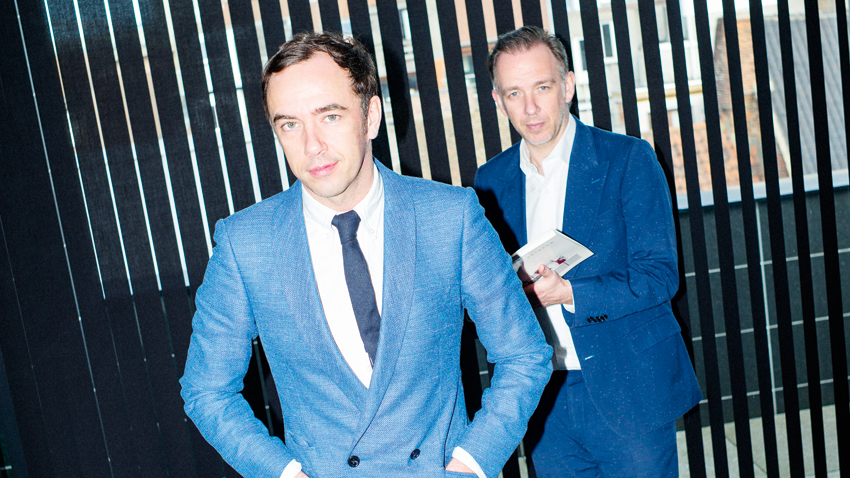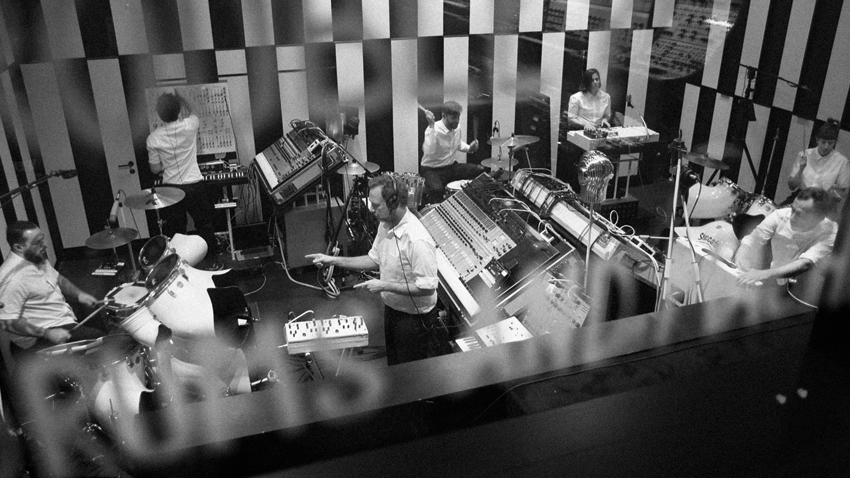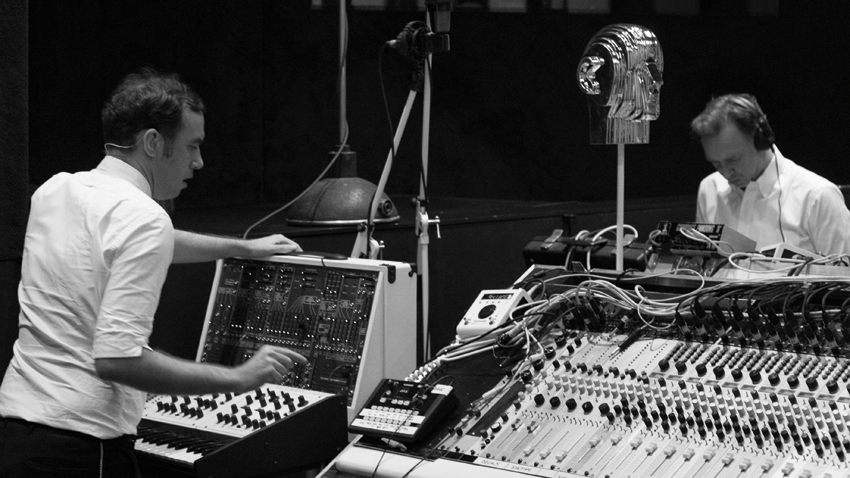Soulwax’s David Dewaele tells the story behind the new album From Deewee
The Belgian badasses are back in style with their new album, recorded live in a single take. Is now the right time to make a comeback?

“Everybody has a passion,” reckons David Dewaele, founder member of acclaimed Belgian tech-rockers Soulwax, and one-half of similarly acclaimed DJ duo, 2manydjs. “Some people like to spend their money on a fancy house. Some people buy Ferraris. We decided to build a studio.”
Calling the Soulwax HQ - known as Deewee - a studio is something of an understatement. After knocking down the shabby garage that housed their old setup, David and his older brother Stephen commissioned a four-story complex
- designed in a minimalist, Japanese style - that houses two Pro Tools studios, penthouse offices, a one-bedroom flat and an entire floor dedicated to their 60,000-plus record collection. There’s even a little room set aside for digitising said mammoth collection of vinyl.
Ghent-based Soulwax - the Dewaele brothers plus bassist and David’s best mate, Stefaan Van Leuven - released their debut album, Leave The Story Untold, in 1996. Alongside the Prodigy, Chemical Brothers and the Foo Fighters, etc, Soulwax’s whirlwind of guitars, grooves and decibels made an immediate impact.
By the time they released album number three, 2004’s Any Minute Now, the Dewaele brothers were shaping Soulwax into much more than just a rock band. The tech-heavy sound – brilliantly captured on the speaker-shredding single, E Talking – felt as comfortable in clubs as it did in festival mosh pits, and invited remix requests from the likes of Daft Punk, Bowie, DJ Shadow and Muse. They even managed to add some sleazy distortion to the Sugababes!
Despite Soulwax’s success, the Dewaele Brothers were also experimenting with their 2manydjs offshoot, the groundbreaking Radio Soulwax mixes, plus soundtracks, films, sound systems and anything else that took their fancy.
“The music industry has an idea of what a band should be,” explains David. “You make an album, you release it, you tour, you do press, you make another album… and that’s your life. We felt we’d already done that, and it didn’t seem to make any sense just repeating the same pattern.
“That’s why me and my brother got involved with so many other projects. Soulwax no longer took up all our time, but we were super busy and our careers really started to fly.”
Get the MusicRadar Newsletter
Want all the hottest music and gear news, reviews, deals, features and more, direct to your inbox? Sign up here.
Although there were remix albums, mix albums and soundtracks, Soulwax didn’t get around to recording an album of new music for 13 years. And they’ve just released it - a sinister, stomping, glam-disco collection called From Deewee.
It might seem like an obvious question, but why now? Why did it feel right to ‘relaunch’ Soulwax?
David Dewaele: “It all started with live shows. Soulwax kept getting asked to play live and, last year, we decided to accept. The problem was that we didn’t have any new material. Just going out on stage and playing the old songs didn’t feel right, so we came up with this idea of taking an analogue studio out on tour with three drummers. We’d play old songs, but also write some new stuff that was based on this new setup. Although we only gave ourselves a month to put it together, it worked!
“After the dates finished, we thought, ‘Why not take that analogue, three-drummer band into the studio and see what happens?’. Me and my brother worked out some new songs and meticulously put them together in Pro Tools; we even programmed the drums exactly as we wanted them to be played by the three drummers. The drum sounds we used were actually samples of those three drum kits.
“Then we brought the band together and rehearsed the whole thing for 12 days straight until we could play the entire album in one take. Note-perfect every time. And that’s how it was recorded - minus the vocals, of course.
“There were a few changes along the way. Especially with the drums. When you’re programming, you kind of forget that a human being has to play the rhythms you’ve created. We soon realised that unless our drummers had eight arms each, that might not be possible. It was all tweaked as we went along, and the finished product is this album.”
Do we call it Soulwax’s most electronic album to date? Last year’s soundtrack project Belgica - which featured a series of fictional bands that were Soulwax in disguise - and the remix collection Nite Versions were heading that way, but this seems fully-loaded with funky synth squelches and MIDI-generated hooks.
“It might sound like it is, but the kit list for this album was fairly limited in terms of synths - just a MacBeth M5N, a really nice, old semimodular machine; one of the new Prophets by Dave Smith; an Oberheim 2 Voice Pro; and a TTSH, which is a copy of the ARP 2600. There’s a guy in Sweden who makes them as a DIY kit, but you need to find a tech who can put it all together. It’s roadworthy, it’s got MIDI and it sounds fantastic.
“What else? A x0xb0x 303 emulator; the new M4000 Mellotron; an EMS Synthi AKS; and the Oberheim OB-Mx, the rack-mounted polysynth.”
When you’re programming, you kind of forget that a human being has to play the rhythms you’ve created. We soon realised that unless our drummers had eight arms each, that might not be possible.
Most producers would be very happy to be ‘limited’ to that little collection of synths.
“Ha ha! Yes, I know what you mean, but I guess what I’m trying to say was that we decided on this kit list, and that was it - nothing more. We’ve got a studio full of crazy vintage gear, and we could have loaded up the computers with another 300 soft synths, but we wanted to give ourselves boundaries. There were seven people in the studio playing this collection of equipment and that’s it - that’s what you hear on the album.”
Not one soft synth?
“When we were putting the album together, yes, there were soft synths all over everything. But it was mainly the stuff that comes with Pro Tools - with a couple of extra sounds from the Arturia Prophet V. And the reason I like the Prophet V is that it doesn’t actually sound like a Prophet - it sounds like a really cool synth. But once we got into the studio, the synth lines were played by hardware.”

How long have you been with Pro Tools?
“Hmmm… maybe 20 years. We were there when it didn’t work with MIDI and you had to run Logic or Cubase alongside it. If I’m being totally honest, Pro Tools can be a complete pain in the ass at times. Yes, it works, and it does the job we need it to do, but there is lots of room for improvement.
“Basically, the issue we have with it is that they profile themselves as the Rolls Royce of DAWs, but all the Abletons and Logics of the world are perhaps the Audi or BMWs - they’re way more versatile and intuitive, and they have more functionality (especially in the case of MIDI) at a lower price. The prestige of driving a Rolls doesn’t weigh up to the fact that it’s a nightmare to find parts for and breaks down just as much as the cheaper cars.
“Apart from the car analogy, the real issue is that after 20 years, we’re not keen to change DAW because we’re totally used to that language now – we have to go along with it begrudgingly. We upgraded our studio system to HDX last year; two identical systems for two control rooms. Every session prior to upgrading is now unrecallable due to plugin incompatibility. It’s now also less reliable, and all of this at a very high price. On top of all that, I find it absolutely insane to charge customers for online support (although granted we don’t have to as we’re HDX customers). Who has ever heard of being charged for being allowed to call customer support before?
“But - and this is a big ‘but’ - even though we have access to almost every other DAW at the studio, I still think that Pro Tools is the most logical program to work with. Sure, Ableton can do some crazy things with loops, but whenever I’m working on a different platform, it feels… it’s like reading a book in a different language. You can translate it and understand what’s written, but you don’t get the beauty and the detail that you do in your own language.”
You kept the recording process relatively simple. Was the mix similarly low-key, or did you start ripping the audio to pieces once it was in the computer?
“We kept everything to a bare minimum because we started to think of this as a ‘live’ album. People who listen to it might never realise it was recorded in this way, but the whole recording process was for us… we know the album was made in a very ‘human’ way.
“The only thing we worked on after it had been recorded was the vocals. And, again, we set ourselves a target: for each track, we gave ourselves one day to write and record vocals, and do the final mix. We were thinking about how bands used to work in the past. If you went into the studio in the 70s, you had a certain amount of time to make an album. If you were unhappy with the album, the record company could still put it out and the only thing you could do was make another album.
“Even the overdubs were limited to anything that was really out of tune. Some of the older synths tended to drift, and if it was too far out, we’d re-record it. We love our old synths, but they can be… temperamental.”
Can we have a poke around in the analogue store room?
“There are one or two very special synths… the Roland System 700, which was their massive modular unit; an Oberheim Eight Voice; a fully expanded Roland System 100. A few by EMS… RMI.”
You’re making us jealous!
“Some of my favourites are the weird, way-out-there synths… wonderful stuff from Italian companies like Steelphon and Elka. And the ETI Maplin synths: 3800, 4600, 5600.
“I love that DIY feel you get from some of the analogue hardware, especially studio outboard. Some guy who made his own version of the 1176. Or the Vortexion preamps that Joe Meek used to use in the 50s and 60s - stick a synth through one of those and you take the sound to a whole new dimension.”
Where do you find this stuff?
“When we first started getting interested in old studio gear - just after we recorded the first album - nobody else was bothered about it. You could go into a junk shop in LA or London and find an MS-20. This was the era of the Nord Lead; analogue was out of fashion.
“These days it’s a lot harder. Occasionally, we pick it up on eBay, but we’ve been collecting it for so long now that we have people all over the world who come to us when they’ve got something interesting.”
A dusty old coal-powered, half-oscillator synth from 1802… who can we flog this to? Ah, Soulwax!
“Ha ha! Yeah, it is a bit like that. But I can guarantee we’re not the only musicians who are like that. Sometimes, we might buy a synth because of the beautiful case or a single sound that captured our imagination. Collecting isn’t always logical. It’s the same with records - how many people reading this have bought a piece of vinyl just because they like the cover?”
Guilty!
“Exactly!”
Collecting isn’t always logical. It’s the same with records - how many people reading this have bought a piece of vinyl just because they like the cover?
Were all the effects and outboard on the album hardware, too?
“Pro Tools and hardware. A lot of the stuff inside Pro Tools gets used, but if you’ve got an 1176 sitting in the studio, why would you use a plugin? We’re in a very lucky position because we’ve built up that collection of hardware over the last 20 years.
“We’ve got an EMT 140 plate reverb, which sounds amazing. There’s a lot of flanging on this album too. For a while now, we’ve been buying up those blue, rackmounted MXR Flanger-Doublers. We’ve got about 12 and we tried sticking everything through there - drums, synths, vocals.
“Having said that, I know that UAD do a version of the 140 plate and some of their other plugins look really interesting. Unfortunately - and this is just my opinion - the problem with most plugins is that they sound like plugins. Especially the maximisers. Yes, it’s great to get some volume and power from a mix, but not if you’re bringing out all the bad stuff… the wrong bits of your music.
“That’s how dance music ended up with the loudness war: the decibels became more important than how the music sounded.”

So how do Soulwax get ‘volume and power’ from a mix.
“We’ve been using the same trick for years. In fact, we’ve been doing it for so long that we barely even think about it. It only gets discussed during interviews like this, or when a mastering studio sends back a mix and says, ‘Sorry, we can’t do anything with this, it’s too loud’.
“We still work on the old Pro Tools 192 I/Os, and there’s a soft-clip function on there… I guess it stops digital distortion. I’ve heard several engineers say that you shouldn’t use it because it will totally change your sound, but we enable that on every mix and it seems to give us what we need.
“There are other ingredients, too. We do record super-loud into Pro Tools - constantly in the red - and we’ve got three equally loud Trident Fleximix desks from the 1970s.
“I know we’ve talked a lot about vintage analogue equipment, but we’re not one of those bands that worship analogue only. This album was made on a Mac Pro with Pro Tools and, to me, they are as much of an instrument as the mixing desk or the EMS synth. The 192s are as important as the 1176.
“Right from day one, I always imagined Soulwax would be a band that could sit comfortably in both the digital and the analogue world; we have one foot in the past and one foot in the future. And it was the arrival of programs like Pro Tools, Logic and Cubase that made it possible to work like that. Finally, you had control of the studio environment in a way that had never been possible before.
“That opened so many doors for us. We were no longer just people in a room playing guitar, bass and drums. You could throw your sound in so many different directions. If I have a drum idea, I can jump on the kit, bang out a rough version and the Mac will help me turn that into a finished piece of music. The studio itself becomes an instrument - an extension of the artist.”
Soulwax’s new album, From Deewee, is out now. Check out their Facebook and Twitter pages for more info and upcoming tour dates.


Computer Music magazine is the world’s best selling publication dedicated solely to making great music with your Mac or PC computer. Each issue it brings its lucky readers the best in cutting-edge tutorials, need-to-know, expert software reviews and even all the tools you actually need to make great music today, courtesy of our legendary CM Plugin Suite.
"Reggae is more freeform than the blues. But more important, reggae is for everyone": Bob Marley and the Wailers' Catch a Fire, track-by-track
“Part of a beautiful American tradition”: A music theory expert explains the country roots of Beyoncé’s Texas Hold ‘Em, and why it also owes a debt to the blues










